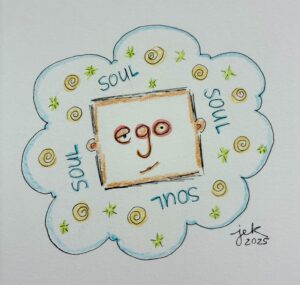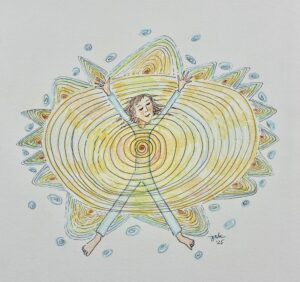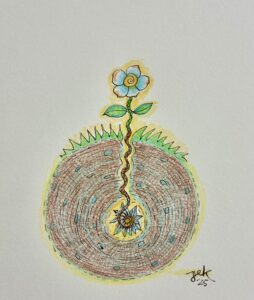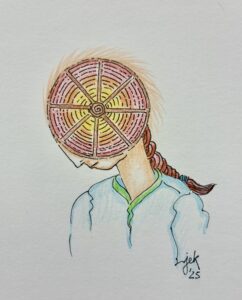
-Artwork © 2025 Jan Ketchel
Thoughts of Carlos Castaneda recently came into my mind. Back in 1998, Deepak Chopra wrote of Carlos, on the jacket of his new book, The Active Side of Infinity: “Carlos Castaneda was one of the most profound and influential thinkers of this century. His insights paved the way for the future evolution of human consciousness. We are all deeply indebted to him.”
But with the publishing, in 2003, of Amy Wallace’s Sorcerer’s Apprentice: My Life With Carlos Castaneda, which revealed her experiences within his inner circle, the final nail was put into the coffin of Carlos ever again being considered a true man of knowledge, or worthy of any legitimate consideration. Instead he became categorized as a typical New Age guru who abused his disciples. I suspect that Carlos made sure that Amy Wallace wrote that book, which ensured he’d be all but forgotten. It shocked not only his followers but the world at large.
Comparable to Chogyam Trungpa Rinpoche, founder of Naropa University, who also fell from grace, Carlos has been, at best, deemed a teacher who employed the cognitive dissonance of crazy wisdom. At worst, he’s been categorized as the greatest fictional trickster of the century, whose shenanigans fooled an entire generation of spiritual seekers. Once branded the Godfather of the New Age, today Carlos Castaneda is essentially a forgotten, discredited man.
Having spent a significant part of my life immersed in his world, I view his current status and exit from this world as a masterful shamanic move, a stroke of genius. I say that because shaman’s recognize self-importance as the number one scourge of humankind, the most negative human characteristic that significantly waylays our ability to spiritually advance. Could the self-importance of world leadership, and the pursuit of likes on social media, which dominate the world at present, not be more validating of this truth?
Carlos wrote 12 books, leaving behind the fullness of his shamanic knowledge, should one be called to it. Yet, should anyone be so called, it would be for the knowledge alone, with no attachment to Castaneda himself. That was his great shamanic maneuver, to ensure that the knowledge be separated from him personally. His reputation aside, he succeeded in delivering his messages, and with no self-importance following him, he sealed the door behind him as he exited human form. How many of us can do our good deeds in the dark, never sharing the knowledge of them with anyone?
When we shed self-importance from our identity, we disconnect from needing to be fortified by the attention of outside energy. Untethered, at death, from the thoughts and feelings of those left behind in human form, our Spirit is completely freed to move deeper into the exploration of infinity. Becoming untethered to the need for outside validation, while still in this world, frees us to follow, impeccably, the intent of our own Spirit, NOW!
Such was the lesson I was taught when my first wife, Jeanne, left this world and I sought our reconnection between worlds, as per our pre-agreement. Ultimately, she informed me to take my attention off her so that she could fully focus her attention upon learning the parameters of her new body and her new world.
Of course, the ultimate irony is that she has talked to my wife, Jan, every day for well over 20 years, in her soul sister messages. Her channelings, however, are not burdened with personal attachment to me. What is delivered is what she deems relevant now, for everyone, from her perspective in infinity. The opportunity for me has been to step up to the refinement of impersonal love.
Both Carlos and Jeanne teach the value of completely losing self-importance through non-attachment; no need for the validation of likes and attention from others. Freed of this imprisonment, we can focus all our energy on the greater good of self, and all others as well, uncompromised by the need for personal recognition. Validation of facts by others is a helpful and a necessary compass as we navigate our spiritual journey, but validation for the sake of self-recognition alone is a path of ego, not a path of heart.
When infinity recently sent me the suggestion to write about Castaneda’s teachings, I pondered which of his books to choose. Ten minutes later someone told me they found a giveaway copy of Carlos’s 1974 book, Tales of Power. Following this synchronistic prompting, I reread the first chapter to see what spoke to me now.
When still in this world, Carlos cautioned us to not attach to the shamanic practices employed upon him during his apprenticeship, which he documented in his three earliest books. Yours is a different time and your journeys are colored by the circumstances of your new age, he said. His suggestion was for us to be guided by the intent of ancient knowledge but to assume full responsibility for formatting its essence into addressing the needs of our time.
The essence of the first chapter of Tales of Power is that we are all double beings, both rational beings, with a solid physical body, as well as lighter energetic beings, with a soul body. Life presents us daily with appointments to obtain knowledge of this true wholeness so that we might more fully realize our fullest potential, while still in human form.
Carlos quotes the Nagual, don Juan Matus: “The only thing we all have in common is that we play tricks in order to force ourselves to abandon the quest. The countermeasure is to persist in spite of all the barriers and disappointments.” (Tales of Power, p. 20.)
Those tricks issue from the rational ego mind, terrified of ego death as it encounters the immensity of, and the powers of, its greater Soul. How quickly ego judges and dismisses its encounters with its soul in the mysterious and often puzzling synchronicities and triggers of daily life.
Synchronicities are creations of the soul of the subconscious mind, offering the ego encounters with the greater knowledge of infinity. In such encounters the subconscious mind is truly manifesting the ego’s intent to evolve, yet the ego often misses its appointments with such knowledge by its counter-intent, which is to survive unscathed the sometimes ruinous demands of greater truth.
The challenge for the ego is to suspend its judgments and refine its reason, to include the parameters of the greater truths of the soul. Reason is essential to navigating infinity, but it must get beyond the stumbling blocks of a solid world that clings tightly to its materialist prejudice.
Triggers are guides from infinity that summon the ego to retrieve its soul through honest recapitulation of its personal history. Typically, the ego gets drawn into self-pity, as it wallows in the offenses committed upon it by others. It holds tightly to the entitlement of retribution before it can forgive. This is a fixation of energy on self-importance, a sidetracking of attention from true knowledge.
Alternatively, the ego can accept all its experiences in life as reflections of all that is. The task is not about forgiveness; there is nothing to forgive. There is only the full retrieval of all of one’s energy, in the full acceptance of one’s life. With this equanimous acceptance of all the acts of one’s life, one is elevated to the highest level of love for all that is.
The barriers that don Juan references, in the above quote, are largely the habitual patterns we live by, as housed in our subconscious mind. Whether they issue from personal history, genetic history, the soul’s intent for this life, or from our ego’s defenses, new habits can manifest, through the persistence of intent and the positive suggestions we consciously and persistently impress upon the subconscious mind.
Persist, persist, persist in lightness and utter calm, and keep those daily appointments with knowledge.
With calm persistence,
Chuck




